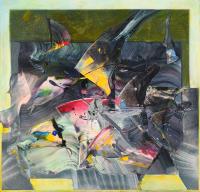
Paul Walden
After many years of apprenticeship in the Germanic school of landscape painting, Paul Walden learned the classical concepts of composition and color. He was then moved by the current stream of free abstraction in American art and wanted to find a middle ground between that freedom and the concepts of prescribed traditional techniques. This resulted in a thirty year-long process of experimentation of both the image and the technique.
“I was once concerned with the relationship between forms--squares, spheres, straight lines--and sought to take forms to their simplest essence which has evolved to my current work. At the same time, I was concerned with the free expression of the intuitive process and the development of a technique that would create spontaneous patterns of color. This achieved two ends: One, even if I repeated a pattern that interested me, the painting would be drastically different each time due to the spontaneity of the elements used in its creation. Two, the subliminal patterns that emerged created a perfect field of “apparent chaos” upon which I could place simplified structures. This achieved the balance between spontaneity and the notion of composition that I sought.”
“I use the phrase ‘apparent chaos,’ because spontaneity--when viewed in a limited sense--only appears chaotic. However, spontaneity has its own intrinsic sense of order due to the subconscious elements of the human mind that created it. It is my belief that the human mind cannot escape order and structure even when involved in spontaneous activities. The repetition of the painting process and the layering techniques I have developed are the tools that allow the intuitive perceptions of an underlying order to emerge.”
“Added to this approach is a continued concern for color and the internal aesthetics of color choice which must play, of course, with the application of light in order to achieve the emotional depth wanted. I view one of my paintings as successful when there is a balance and harmony between all these elements, thus giving the painting a luminous quality.”
Although his current work marks a major transition, the aesthetic continuity is apparent. Paul Walden feels that as any artist develops, they work upon the past, and when they mature--they need not break from the past--rather, with all their strength and spirit, build a new future.